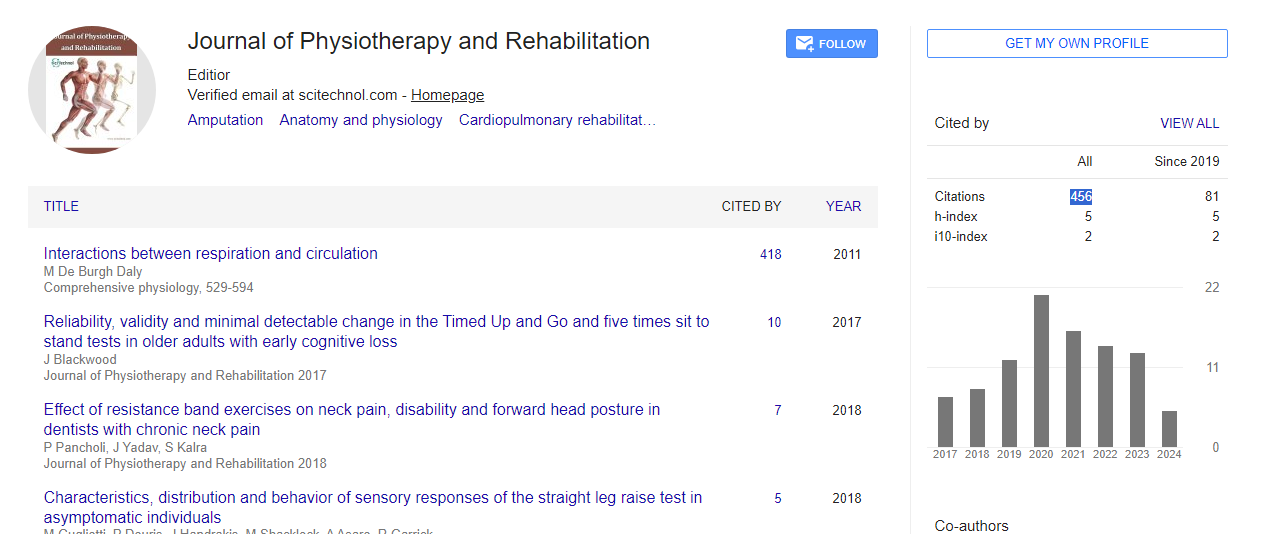Perspective, J Physiother Rehabi Vol: 8 Issue: 1
Breaking Down Rehabilitation: A Bio-Mechanistic Approach
Nishiyama Kurtz*
1Department of Neurology, Kumamoto University, Kumamoto, Japan
*Corresponding Author: Nishiyama Kurtz,
Department of Neurology, Kumamoto
University, Kumamoto, Japan
E-mail: kurtznish@kuh.kumamoto-u.ac.jp
Received date: 02 January, 2024, Manuscript No. JPTR-24-134533;
Editor assigned date: 04 January, 2024, PreQC No. JPTR-24-134533 (PQ);
Reviewed date: 18 January, 2024, QC No. JPTR-24-134533;
Revised date: 26 January, 2024, Manuscript No. JPTR-24-134533 (R);
Published date: 02 February, 2024, DOI: 10.4172/JPTR.1000161.
Citation: Kurtz N (2024) Breaking Down Rehabilitation: A Bio-Mechanistic Approach. J Physiother Rehabi 8:1.
Description
Rehabilitation is a multifaceted journey, encompassing various therapeutic modalities aimed at restoring function and improving quality of life following injury, illness, or disability. While the process may seem complex, at its core lies a fundamental understanding of the body's bio-mechanisms and how they contribute to recovery. In this article, we delve into the give and take between biology and mechanics in rehabilitation, shedding light on the bio-mechanistic approach to healing.
At the heart of rehabilitation is the body's remarkable capacity to adapt and repair itself. From the cellular level to the musculoskeletal system, a precipitation of bio-mechanical processes is set into motion to facilitate recovery. Understanding these processes is essential for developing targeted interventions that optimize outcomes for patients.
One of the key bio-mechanisms involved in rehabilitation is tissue regeneration. When tissues are damaged due to injury or disease, the body initiates a series of biological responses aimed at repairing the damage. This includes the proliferation of cells such as fibroblasts, which produce collagen to rebuild connective tissue, and osteoblasts, which facilitate bone healing. By understanding the molecular pathways that govern tissue regeneration, clinicians can develop interventions to enhance the healing process, such as regenerative therapies and tissue engineering techniques.
Another critical aspect of rehabilitation is neuromuscular reeducation. Following injury or prolonged disuse, the neuromuscular system undergoes changes that can impair movement and coordination. Through targeted exercises and therapeutic interventions, patients can retrain their nervous system to communicate more effectively with their muscles, restoring optimal movement patterns and function. This process relies on the principles of neuroplasticity, the brain's ability to reorganize itself in response to new experiences, which forms the basis of motor learning and skill acquisition.
In addition to tissue regeneration and neuromuscular re-education, biomechanics plays a important role in rehabilitation. Biomechanical principles govern how forces are transmitted through the body during movement, impacting joint stability, muscle function, and overall movement efficiency. By analyzing movement patterns and biomechanical dynamics, clinicians can identify areas of dysfunction and implement interventions to optimize movement mechanics and reduce the risk of injury. This may involve the use of orthotics, prosthetics, or assistive devices to support proper alignment and function.
Furthermore, the bio-mechanistic approach to rehabilitation extends beyond the individual to consider the broader systemic factors that influence recovery. This includes factors such as nutrition, sleep, and psychological well-being, all of which play integral roles in supporting the body's bio-mechanical processes. Adequate nutrition provides the essential building blocks for tissue repair and regeneration, while sufficient rest allows the body to recover and adapt to the demands of rehabilitation. Moreover, addressing psychological factors such as stress and anxiety is essential for promoting a positive mindset and enhancing the body's ability to heal.
 Spanish
Spanish  Chinese
Chinese  Russian
Russian  German
German  French
French  Japanese
Japanese  Portuguese
Portuguese  Hindi
Hindi 